Papers by M. Önder Göncüoğlu
Heidegger’De Dasein Ve Angst: Ingmar Bergman’In Persona’Sinda Varoluş Anksi̇yetesi̇
Dokuz Eylül Üniversitesi Sosyal Bilimler Enstitüsü Dergisi
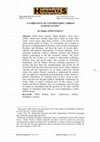
HUMANITAS - Uluslararası Sosyal Bilimler Dergisi
Nobel Prize laureate Orhan Pamuk's novel Snow (2002), which local scholars argue that it takes it... more Nobel Prize laureate Orhan Pamuk's novel Snow (2002), which local scholars argue that it takes its name from 'karsu' (snow-water), takes place in Kars 3 , a city located on the northeastern border of Turkey. As a borderline city, it stands as the nexus of distinguished civilisations, such as that of Armenians, Russians, and Ottomans; and bears the traces of several ethnic, cultural, and political characteristics of diverse identities. Snow represents modernist Turkey's political, cultural, and religious turmoil experienced in the late twentieth century. The novel depicts the city of Kars as a witness to deep-seated conflicting political views and social values. The concepts of secularism, nationalism, and the Islamic Revival, including experiences of poverty that have been felt, unemployment, and suicide are all inscribed within the plot of this provocative novel. Hence, depicted concepts and felt experiences stir up much controversy among critics who explore Pamuk's intention to understand the reasons why he might have thematised such problematic issues. However, Pamuk's elaboration of a political issue in Snow seems to have been misconceived through political standpoints minimizing his artistic ability to solely a political gaze. In this respect, I will explore and discuss Pamuk's Snow as a polyphonic novel inviting its readers to contemplate both the question of 'the other' and the dangers of radicalism rather than as a novel supporting a certain political group.
According to a common belief, anxiety can be an experience of a certain degree of powerlessness b... more According to a common belief, anxiety can be an experience of a certain degree of powerlessness because a person suffering from anxiety is hampered as a person who cannot possess a particular category of power. This lack of a desired power manifests as the source of emotion that results in anxiety. Because fear and anxiety are commonly used interchangeably in ordinary discourse, fear is often used erroneously instead of anxiety when, under further examination, anxiety would be the preferable usage. However, shedding light on the by bringing forth the personality of a successful actress, found in Elizabeth Vogler (Liv Ullmann)'s story, where she seems to be suffering from an enigmatic mental collapse with symptoms such as muteness and a near catatonic lassitude.
Gaziantep University Journal of Social Sciences, 2019
Philip Roth‘s The Human Stain (2000) simply tells the story of a New England classics professor, ... more Philip Roth‘s The Human Stain (2000) simply tells the story of a New England classics professor, Coleman Silk, who is forced to quit his job for alleged racism. The charge is a lie, but the truth about Silk is more
shocking because it turns out that for his entire adult life, Silk has been covering up the fact that he is neither Jewish nor white although he is actually a very light-skinned man. The stain given in the title of this novel stands for both a mark on the skin and the mark of our experienced based stories, and which, consequently construct our identities. This paper, therefore, analyzes how the idea of 'stain‘ is ironically inscribed both socially and individually into our identities.
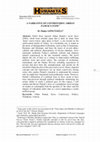
Humanitas, 2018
Nobel Prize laureate Orhan Pamuk's novel Snow (2002), which local scholars argue that it takes it... more Nobel Prize laureate Orhan Pamuk's novel Snow (2002), which local scholars argue that it takes its name from 'karsu' (snow-water), takes place in Kars 3 , a city located on the northeastern border of Turkey. As a borderline city, it stands as the nexus of distinguished civilisations, such as that of Armenians, Russians, and Ottomans; and bears the traces of several ethnic, cultural, and political characteristics of diverse identities. Snow represents modernist Turkey's political, cultural, and religious turmoil experienced in the late twentieth century. The novel depicts the city of Kars as a witness to deep-seated conflicting political views and social values. The concepts of secularism, nationalism, and the Islamic Revival, including experiences of poverty that have been felt, unemployment, and suicide are all inscribed within the plot of this provocative novel. Hence, depicted concepts and felt experiences stir up much controversy among critics who explore Pamuk's intention to understand the reasons why he might have thematised such problematic issues. However, Pamuk's elaboration of a political issue in Snow seems to have been misconceived through political standpoints minimizing his artistic ability to solely a political gaze. In this respect, I will explore and discuss Pamuk's Snow as a polyphonic novel inviting its readers to contemplate both the question of 'the other' and the dangers of radicalism rather than as a novel supporting a certain political group.
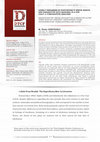
DTCF Dergisi, 2017
Loneliness is a universal phenomenon that individuals experience at some point their lives regard... more Loneliness is a universal phenomenon that individuals experience at some point their lives regardless of their culture. Hence, the concept of loneliness has been repeatedly discussed and analyzed not only by philosophers, sociologists, psychologists, but also by a great number of writers all through history because of its pervasive role in our individual and social lives. While loneliness as a theme, in general, is employed along with the idea of alienation, in Russian literature, it seems to be related to the term of 'superuous man.' The ideas of dream and love, likewise, have been reected in many works of art and literature. In this light, this paper, within a comparative framework, analyzes two outstanding works-Fyodor Dostoevsky's White Nights (1848) and Sabahattin Ali's Madonna in a Fur Coat (1943)-in terms of their main characters' superuous tendencies diversied by the themes of loneliness, dream, and love. Yalnızlık, kültür ayırt etmeksizin bireylerin yaşamlarının belli dönemlerinde tecrübe ettikleri bir durum olarak insan varoluşunun en evrensel temalarından biridir. Yaşamımızın her safhasında etkin bir role sahip olduğundan yalnız belirli disiplinlerin uzmanlarınca-felsefeciler, sosyologlar ve psikologlar gibi-tartışılmamış insanlık tarihi boyunca pek çok yazarın eserine de konu olmuştur. Genel olarak yabancılaşma teması etrafında tartışılmış olan yalnızlık sorunsalı Rus Edebiyatında 'lüzümsuz adam' kavramıyla bambaşka bir veçhe kazanmıştır. Yalnızlık temasına paralel olarak aşk ve hayal temaları da pek çok edebi eserde kullanılmıştır. Aşk, hayal ve yalnızlık kavramlarını merkeze alan bu çalışma Dostoevski'nin Beyaz Geceler'i ile Sabahattin Ali'nin Kürk Mantolu Madonna adlı eserlerindeki ana karakterleri 'lüzümsuz adam' kavramı etrafında karşılaştırmalı olarak tartışan bir çalışmadır.
NORTH DAKOTA QUARTERLY, 2017
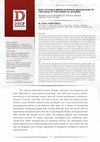
DTCF Dergisi, 2016
This study, as a critical examination, unravels how the non-Western woman has been both reconstru... more This study, as a critical examination, unravels how the non-Western woman has been both reconstructed and represented from a Western male perspective. The representation of Harem and the idea of the ideal Oriental woman in Harem have been analysed repeatedly in scholarly circles. However, this study analyses primarily how the women Bu makale, Batılı olmayan kadın imgesinin Batılı erkek bakış açısıyla yeniden inşa edilerek nasıl temsil edildiğini analiz eden bir çalışmadır. Ancak akademik çalışmalarda sıklıkla karşılaşılan 'Osmanlı'da Harem ve Kadın' temsillerinin aksine bu çalışma temel olarak 19.yüzyılda Osmanlı İmparatorluğu'nun Kuzey Afrika'daki etkisini kaybetmesi sonrası Batı merceğinde 'Mağripli Kadın' temsilinin nasıl değiştiğini incelemektedir. Bu amaçla genelde 'Batılı-olmayan Kadın' imgesinin, özelde de 'Osmanlı Doğusuna ait Kadın' imgesinin temsili ve beraberinde yeniden inşası Alman, Fransız, İngiliz vb. gibi Batı Avrupa yazınsal kaynaklarına ve görsel literatürüne ait örnekler-seyahatnameler, posta kartları, tablolar-üzerinden incelenmiştir. Bahsi geçen bu kaynakların genel bir kabul ve meşruiyet çerçevesi oluşturma aracı olarak nasıl kullanıldığı ve Öteki ile ötekiliğe ait kimlik krinin 'kadın' imgesi üzerinden temsili tartışılmıştır. The mutual relationship between ideology, discourse, and hegemony has been inuential on post-colonial scholarship, and travel and cultural studies, particularly in the twentieth century with the critical contributions of Althusser, Gramsci, Foucault, and Said. The role of stories told about the Orient and the Western visual literature likewise reveal and depict a lot in this context about the presumptuous psyche of the Western male gaze. As a means of transferring information, introducing people and creating identities, both the stories and the illustrations have always had a vital role in moulding the viewers' perceptions about what should and should not be reality. By shaping opinions and presenting meticulous versions of 'reality', fabricated stereotypes have, frequently, been constructed. Either through print or broadcast sources, the illustrations have always inuenced our understanding of the world around us. As a result, the real and the imaginary have become impossible to distinguish through the means of representations.

idil, 2016
'Modernity' dissolved religious tradition and increased spiritual anarchy in thought and action i... more 'Modernity' dissolved religious tradition and increased spiritual anarchy in thought and action in the late nineteenth century. In this highly scientific age, the emerging theoretical works of Marx, Engels, Darwin, Nietzsche, and Freud on god, race, evolution, class struggle, and the human spirit, unsurprisingly produced the first deliriums of modern man. People in such an environment lost their sense of security and their lives could no longer assure spiritual serenity. As a milestone of the late Nineteenth Century, Nietzsche in The Gay Science obviously proclaimed that God is dead. God remains dead. And we have killed him. Therefore, standing amidst the clash between Victorian romanticism and twentieth-century scepticism, Henry Rider Haggard seems to have been affected by the confusions of his era. Therefore, the primary goal of this article is to clarify in what ways the British Africanist H. R. Haggard was affected by the winds of change occurred in his time (1856-1925) and how he represented the discourse of 'the hermeneutics of suspicion" in his works. 1 This article is reproduced-but is revisited using a new critical terminology-from the author's dissertation. 2 Assist. Prof. Dr.,
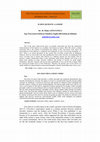
Dicle Üniversitesi Sosyal Bilimler Enstitüsü Dergisi , 2012
One of the most controversial issues in academic discussions has been the inconsistent characteri... more One of the most controversial issues in academic discussions has been the inconsistent characterisation of Don Quixote as a madman with instances of sanity. What this article is mainly concerned with is the analysis of particularly the ending of this well known work where the representation of Don Quixote is completely left ambiguous in terms of his being triumphant or a loser. There is no critical agreement on the reasons why Cervantes created such an ambiguous character. However what seems to be clear regarding this issue is that, from the very beginning of the novel, Cervantes tries to portray Don Quixote as a madman, because the story begins with the narrator's explicit interpretation about a poor gentleman called Alonso Quijano who seems to go insane from reading too many chivalric romances and decides to become an errant knight. Nonetheless, Quixote's madness and naiveté seem undoubtedly to have put his life in danger while his restoring his health seems to have killed him. Therefore, the primary goal of this article is to clarify whether his alleged madness represented through his chivalric deeds makes him a loser or not.
Books by M. Önder Göncüoğlu
Cambridge Scholars Publishing: Literature and Psychology: Writing, Trauma and the Self, 2019
Kriter: Batı Edebiyatında Mizah /Humour in Western Literature, 2016
Cambridge Scholars Publishing: Mythmaking across Boundaries , 2016


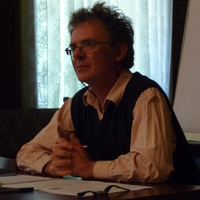








Uploads
Papers by M. Önder Göncüoğlu
shocking because it turns out that for his entire adult life, Silk has been covering up the fact that he is neither Jewish nor white although he is actually a very light-skinned man. The stain given in the title of this novel stands for both a mark on the skin and the mark of our experienced based stories, and which, consequently construct our identities. This paper, therefore, analyzes how the idea of 'stain‘ is ironically inscribed both socially and individually into our identities.
Books by M. Önder Göncüoğlu
shocking because it turns out that for his entire adult life, Silk has been covering up the fact that he is neither Jewish nor white although he is actually a very light-skinned man. The stain given in the title of this novel stands for both a mark on the skin and the mark of our experienced based stories, and which, consequently construct our identities. This paper, therefore, analyzes how the idea of 'stain‘ is ironically inscribed both socially and individually into our identities.